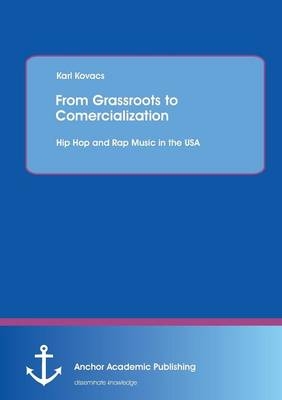
From Grassroots to Comercialization: Hip Hop and Rap Music in the USA
Anchor Academic Publishing (Verlag)
978-3-95489-251-8 (ISBN)
Nowadays one could not imagine chart shows, discos or house-parties without rap music. According to Guthrie P. Ramsey, Jr., rap music, which belongs under the cultural umbrella called hip hop, is virtually everywhere: television, radio, film, magazines, art galleries, and in underground culture .
In this work Karl Kovacs will examine the reasons for hip hop s international success, the dangers of it, and the motivations rappers had and still have to pursue their art. It is yet to be answered if the success of this form of art has been a blessing or a curse for its performers and their audience, the so-called hip hop generation.
Karl Kovacs was born on 15. June 1981 in Arad/Romania. He studied English and History at Albert-Ludwigs University in Freiburg and graduated in 2009.
Kovacs has released several term papers as well as an experimental book: Blinded bound bewildered broke but beautifully blessed (ISBN: 978-1494774431).
The author works as editor for the newspaper Offenburger Tageblatt and is married to Stephanie Kovacs.
For further information please visit www.art-kovacs.de.
Chapter III., Political Rap Knowledge and Community Control:
At the end of the 1980s and the beginning of the 1990s two important subgenres of rap music emerged. Political rappers offer a form of social and political criticism that is less crime-oriented than their gangsta-counterparts . However, this does not mean that they are less radical regarding their opinions and messages. But this first difference indicates that political rappers are more concerned about the whole African American community and its status in the American society, whilst the gangstas seem to concentrate on telling what is going on and how certain individuals manage to live in, or rather survive, the ghetto. Ernest Allen, Jr. points out that the gangstas are concentrated on individualistic solutions of social problems whilst the others tend toward more collective ones (Allen 1996: 169). In spite of the fact that the two types of rap music share a common feature, an antisocial character with respect to the dominant society (ibid.), in both forms women are displayed as being inferior (gangsta) or at least as being in need of protection (political/conscious).
According to William Eric Perkins, however, political rap is much more useful for the purpose of making oneself heard and to change the situation (of blacks) in a positive sense. He instances the rap group Public Enemy (PE) with their charismatic front man Chuck D and the comical Flavor Flav as the standard by which all political rap should be judged (Perkins 1996: 21). Tricia Rose calls these rappers prophets of rage who keep poor folks alert and prevent[s] them from being lulled into submission by placating and misleading media stories and official truths (Rose 1994: 99).
[ ]
Chapter III.1., The Emergence and Manifestations of Political Rap:
The roots of political rap can be traced back to the 1960s and 1970s when rap music s forefathers such as the Last Poets and Gil Scott-Heron released songs with political contents. Moreover, the black poetry movement of the sixties with its specific content traceable to the sociopolitical thought of African American from that period to the present (Allen 1996: 161) has to be mentioned as another source.
Public Enemy contributed a lot to the development of political rap. Their first album: Yo! Bum Rush the Show , which was released in 1987, even kicked off this genre. The second group that played an important role for political rap was called Boogie Down Productions (BDP) with protagonist-rapper KRS-One. Beside these two outstanding groups there are several more that should be mentioned here. Among them are artists such as Paris, Jungle Brothers and A Tribe Called Quest.
According to Ernest Allen, Jr. there are several categories into which political rap can be classified. He talks about cultural-political nationalism (Public Enemy (PE), Boogie Down Productions (BDP) [ ], and specific, message-oriented expressions embedded in [ ] more earthly gangsta rap (N.W.A., Ice Cube, Ice-T) (Allen 1996: 162). But it is necessary to divide these into subcategories as the contents and messages of political rappers who belong to the same category sometimes differ. For example, PE and BDP belong to the cultural-political category but their ideas of how to improve the situation of African Americans are different.
In spite of the differences in the messages, all of the mentioned artists have one thing in common: By portraying the everyday life of African Americans they try to make a difference with their music.
Ernest Allen, Jr. explains one should primarily distinguish between those rappers who see education and those viewing community control as the major means to achieve self-empowerment and some sort of equality (cf. ibid.).
| Erscheint lt. Verlag | 15.4.2014 |
|---|---|
| Sprache | englisch |
| Maße | 155 x 220 mm |
| Gewicht | 153 g |
| Themenwelt | Sozialwissenschaften ► Soziologie ► Allgemeine Soziologie |
| ISBN-10 | 3-95489-251-0 / 3954892510 |
| ISBN-13 | 978-3-95489-251-8 / 9783954892518 |
| Zustand | Neuware |
| Haben Sie eine Frage zum Produkt? |
aus dem Bereich


